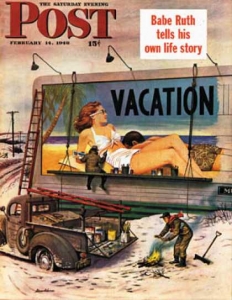
Stevan Dohanos (1907-1994)|Billboard Painters in Winter|Cover illustration for The Saturday Evening Post (February 14, 1948)In the late 1940s and 50s illustrator Stevan Dohanos painted over one hundred and twenty cover illustrations for The Saturday Evening Post. His style is often compared to Norman Rockwell, although Dohanos’ choice of subject differed. While Rockwell is noted for idealizing American life, Dohanos illustrated suburban and small town reality by documenting the ordinary, everyday images of American people; Dohanos emphasizes the subject’s environment rather than just the people themselves.Stevan Dohanos (1907-1994)|Billboard Painters|Cover illustration for The Saturday Evening Post (July 13, 1957)
Dohanos images tend to have a sense of humor and optimism as is evident in these two covers for The Post. On two different occasions he created images of billboard artists painting seasonal advertisements during the opposite time of the year. The February 14, 1948 Post cover portrays billboard painters dressed warmly in winter clothing and working in the snowy conditions painting a billboard that advertises a couple relaxing in the warm sun on a tropical beach. Although there is no instrument indicating the temperature, the white blanketed landscape indicates the cold wintery season and the painter to the right is shown warming his hands over a make shift fire.
The July 13, 1957 cover reveals to the reader the sweltering summer heat as the thermometer positioned toward the top of the billboard displays a temperature reaching 95 degrees. The two billboard painters have removed their work coats which are draped on the truck. On the left, the painter is enjoying a cool refreshing drink and his collaborator to the right is pouring himself a revitalizing glass of water. Ironically the painters have created a billboard sign in cool colors portraying polar bears and glaciers advertising an air conditioning unit.
This Post cover also reveals information regarding popular culture of the period. Air conditioning, invented by Willis Carrier, by the 1920s was installed in industrial buildings, department stores, railroad cars, and movie theaters. It was not until after WWII that air conditioning units began appearing more frequently in homes. Between 1948 and 1953, sales of air conditioning units increased from 74,000 to over one million.*
Dohanos was born to Hungarian immigrant parents in the steel mill town of Lorain, Ohio. His artistic talents were noticed when he began creating calendar posters for co-workers at the steel mill where he worked. With the encouragement of friends and family, Dohanos enrolled in the Cleveland School of Art. After graduation, he worked as a billboard artist painting signs and lettering. In the early 1940’s he moved to Westport, Connecticut and began submitting art work to the Saturday Evening Post and other clients. In Westport, Dohanos, Norman Rockwell, along with other artists and illustrators founded the Famous Artists School.
After WWII, as car ownership increased so too did the number of people using American highways thus creating opportunities for an abundance of roadside billboard advertisements. Today it is more common to see billboards constructed from print material, but during the 1940’s and 1950’s large advertising billboards were often painted by hand. What makes these Dohanos cover illustrations unusual is that billboard artists are not generally noticed, nor are they recognized for their artistry. By depicting the billboard painters marked with splashes of paint and the tools of their trade in hand and nearby, Stevan Dohanos elevated (literally and figuratively) both the artists and their work.
*https://www.air-conditioners-and-heaters.com/air_conditioning_history.html
August 12, 2010
By Colleen Boyle for the Rockwell Center for American Visual Studies
Norman Rockwell Museum






